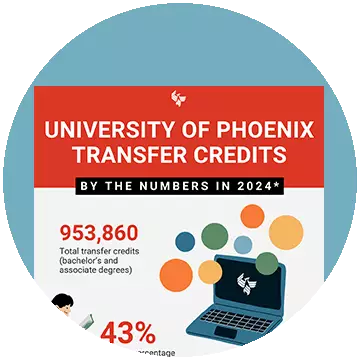Articles > Admissions > Using the college credit transfer process to return to school
Using the college credit transfer process to return to school

Written by Dillon Price

Reviewed by Devin Andrews, Vice President, Office of Admissions & Evaluation, University of Phoenix

Life has a way of taking us on unexpected detours, and sometimes that means pausing your college education. Did you put your degree on hold to start a family? Perhaps you decided to set aside the books to start working. Whatever the reason, the good news is that a college credit transfer opportunity can help you pick up right where you left off.
Sort of.
How you can apply your previous college credit to a new program depends on your chosen school’s program policies, articulation agreements and the relevance of your previous coursework.
Read more to learn how you can apply your credit and complete that long-awaited college degree!
Why should you consider a college credit transfer?
Some people return to college to change careers, stay updated with industry trends or gain a new set of skills. Others are looking for a career shift that better aligns with their passions and skills.
For many, the prospect of starting a degree program can feel daunting. That’s where transferring your college credits enters the picture. This process can allow you to build upon the academic groundwork you’ve already laid.
If your goals have changed since starting a degree program, that’s OK. Often, college credits from general education courses transfer, even if you’ve decided to pursue a bachelor’s degree instead of an associate degree or are changing your field of study altogether. Again, that’s an “often,” not an “always.” There are many caveats when it comes to transferring credits.
You’ve earned those credits — don’t let them go to waste!
The credits you’ve earned are more than just numbers on a transcript — they represent the time, effort and money you’ve invested in your education. Allowing them to go unused could be a missed opportunity.
However, you may be concerned whether old credits are still valid . The good news is that once you’ve earned college credits, they stay on your transcript forever. However, not all credits are transferable.
Most general education course credits (e.g., English, basic science and history) remain valid for years, sometimes even decades. You can often apply them to a new degree program.
Credits from STEM-related courses may not transfer after about 10 years because those fields undergo rapid advancements. Graduate-level credits often have an even shorter shelf life, which is typically about seven years. However, this greatly varies by institution.
Financial benefits of college credit transfers
One potential benefit of transferring your credits is being able to save on your future tuition costs because you don’t have to pay to take those same classes again, this time for your new chosen degree. This is especially valuable if you’re heading back to school on a budget.
Beyond tuition savings, some colleges and universities offer scholarships and grants specifically for transfer students. Those offers, along with financial aid opportunities, can help ease the financial transition as you continue your education at a new institution.
Understanding the college credit transfer process
When considering the transfer process , explore the following steps.
1. Consider pre-enrollment, the planning stage when you explore the “what ifs.” Use this time to decide whether you’ll be a part-time or full-time student and determine whether you can transfer credits if you change your field of study.
2. Next, give some thought to the enrollment and application stage. Can you talk to an enrollment or admissions representative to learn more about what credits are required, which can transfer and what your timeline and budget will realistically look like? Also, thoroughly research the criteria you need to meet before being accepted.
3. Then comes the post-enrollment stage. The college formally evaluates the course credits, assigns each course to a specific set of degree requirements and generates a degree audit report.
How to research and choose schools that accept transfer credits
When planning to transfer your college credits, one of the most important steps is finding a school that accepts your credits and also aligns with your academic and career goals.
You may want to look for schools that have articulation agreements with your previous college. These formal agreements outline how credits will transfer between institutions. They also help ensure that your hard-earned credits are recognized and applied toward your degree at the new school.
Common requirements and restrictions for a credit transfer
Colleges have specific requirements for transferring credits. They’ll look at the accreditation of your previous institution, the relevance of your completed courses to your new program and your grades.
Colleges also exercise discretion in accepting credits. Different institutions have varying policies. They consider where your credits come from, how old your coursework is and how well it aligns with their curriculum. Credits from nonaccredited institutions or outdated courses may face more scrutiny and are less likely to be accepted.
This is particularly common in fast-evolving fields such as computer science, engineering or information technology.
Strategies for maximizing the number of credits you can transfer
Transferring college credits doesn’t have to feel like starting from scratch. With some planning, you can make sure that more of your hard-earned credits count toward your new degree. Here are some effective strategies to consider:
Be aware of college credit transfer policies
Colleges publish their policies on how many and which transfer credits they will accept. Choosing a “transfer-friendly” school can be beneficial for both your time and wallet.
To ensure you’re getting the most out of your efforts, talk with an enrollment or admissions representative at your chosen college. They can help ensure you receive all the credits you’re eligible for.
Submit all relevant transcripts
To maximize the number of college credits you can transfer, submit all your transcripts from previous institutions. You can also include credits from Advanced Placement exams you’ve taken or military credits you’ve completed (which are different from transfer credits).
You can obtain your unofficial transcripts from the registrar’s office at each college you attended. Some colleges allow you to access them directly through your student portal.
Explore credit for work or life experience
You don’t always need to finish college coursework to earn credits. Sometimes, the best classroom is life itself. Consider exploring alternative ways to get college credits .
For example, if you’ve gained substantial knowledge through work, life experience or independent study, passing the College-Level Examination Program (CLEP) exam in that subject can translate into college credits. CLEP can help you fulfill general education or elective requirements.
You can even earn credits by completing short, self-paced courses with alternative credit providers such as Study.com, Straighterline or Sophia . For example, Study.com is a platform that allows you to complete upper- and lower-division courses, and other providers offer similar pathways to college credits.
Consider appealing credit rejections
College credits might not be accepted if the course content doesn’t align closely enough with the curriculum at the new institution, or if a student exceeds the maximum number of credits that can be transferred.
Additionally, credits may not be applied due to perceived differences in academic rigor.
If a college does not apply your credits, you’re not completely out of options. You could appeal the decision, especially by working directly with the academic departments that handle the courses in question.
Using college credit transfers to attend online college
Maximize your previous academic achievements by transferring your credits to University of Phoenix, where online programs are designed specifically for working adults. The University offers an easy college credit transfer process
and the resources to help you get started
. Ask for more information
today.
Transfer Credits by the Numbers: An Overview
University of Phoenix's Transfer Credits by the Numbers in 2024 infographic highlights the impact of transfer credits on saving time and money. Additionally, it breaks down the average transfer credits by college, showcasing how students across various disciplines benefit from this opportunity.


ABOUT THE AUTHOR
Dillon Price is a detail-oriented writer with a background in legal and career-focused content. He has written and edited blogs for dozens of law firms, as well as Law.com. Additionally, he wrote numerous career advice articles for Monster.com during the company’s recent rebranding. Dillon lives in Western Massachusetts and stays in Portugal each summer with his family.

ABOUT THE REVIEWER
Devin Andrews is the vice president of admissions and evaluation at University of Phoenix. She has experience leading University-wide initiatives related to technology and innovation to improve outcomes for diverse stakeholders, including improving the experience for transfer students and increasing credit for prior learning through improved awareness, experience and cost-savings measures for students. She holds a bachelor’s degree in political science from University of Arizona and a Master of Business Administration and Master of Arts in Education from University of Phoenix.
This article has been vetted by University of Phoenix's editorial advisory committee.
Read more about our editorial process.



